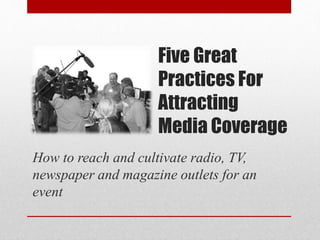
5 Practices for Attracting Media Coverage
- 1. Five Great Practices For Attracting Media Coverage How to reach and cultivate radio, TV, newspaper and magazine outlets for an event
- 2. - Jerry Seinfeld, American Comedian “It's amazing that the amount of news that happens in the world everyday always just exactly fits the newspaper.”
- 3. Event planning involves significant preparation. You have to consider the technical arrangement of lights and sound, the functional needs of hosting guests, and the kinds of promotion that surround and integrate with the audience. Moreover, there are aspects of scheduling to be considered, the safety of attendees, and the generation of story material. You may all these bases covered, but still face the challenge of attracting the conventional media to attend and tell your story. There is grassroots coverage one can employ by simply posting pictures and videos on social platforms which has some value. Nonetheless, how do you attract established media sources such as radio, TV, newspaper and magazine outlets? The presentation here captures a number of practices one can employ.
- 4. #1 Speak the Language of News Reporters
- 5. • Speak the language of the journalist. Use the nomenclature that reporters and commentators use in gathering and dispensing news. Share why the story is "timely and relevant." Explain why the story has "legs" beyond a news cycle. Note if you have a journalism degree or have worked in the past as a reporter then let your contact know that you belong to the same tribe— the storytellers of real events— and build rapport.
- 6. #2 Know What Motivates a Media Reporter
- 7. The media world has its own psychology over what makes a story newsworthy which may not match up with perceptions of event planners. Media reporters aren’t always compelled to cover a story that’s “bigger,” “better,” “the first” or “the last” of some event, product or personality. When approaching individual writers and reporters along with their papers, stations and web journals…ask yourself two questions: What stories surrounding the event ADVANCE THE CAREER of the journalist? What stories are attractive (INCREASE SALES and/or INTEREST) for the company medium of communication the journalist represents? The bottom line involves what is good for the media writer and companies they represent.
- 8. #3 Cultivate Stringers and Independent Media Sources
- 9. Some organizers think news coverage is secured by first pursuing full-time staff writers and reporters while overlooking independent news hunters. One of the best sources for effective media coverage can be found in cultivating relationships with alternative newsgathering professionals. Stringers, freelancers and independent media professionals are highly motivated to find good story material. These media reporters make a living in finding overlooked stories. They pitch stories related to your event (eliminating your need to penetrate the circle of decision makers). Freelancers and independents tend to be easier to contact, too. They are a superb resource.
- 10. #4 The Response to Media Queries is one of Top Priority
- 11. Most people understand that responding to a journalist's call or question as soon as possible is important. However, when juggling a dozen other issues related to event management, it's easy to delay a quick response. Nonetheless, it's imperative to respond to the query of a reporter in a timely fashion. Media reporters live in the world of DEADLINES. Your quick response builds CREDIBILITY with that media reporter that you have made her or him a top priority. You will be seen as a reliable and responsive source for quotes and information under DEADLINE pressures. It cannot be understated as to how the consistent integration of this practice produces significant results in media circles.
- 12. #5 Give Media Reporters Pithy, Pungent and Powerful Lines
- 13. What makes a good story isn't always the size of an event, products being displayed or the appearance of a celebrity. Media reporters want to know they can secure from you extremely quotable material. Great quotes make the media reporter's story "sizzle," "stand out" and "connect" with their consumers. It's an art to train yourself or to find people in your organization/event who can juxtapose words in combinations that are incredibly potent for reporters to use. Quotes that engage the theatre of the mind, use word-play, alliteration or involve hard numbers and facts are attractive.
- 14. By being quotable (Practice #5), responsive to queries (Practice #4), resourceful in using independent reporters (Practice #3), knowing the psychology of what drives media reporters (Practice #2), and using the language of the reporter to connect with him/her (practice #1)... you raise the probability of obtaining media coverage for your event. And...
- 15. ...you will create great PARTNERSHIPS with those who report news. For PR professionals, MEDIA RELATIONS is the art of ethically managing the needs of reporters and the quality of the stories being told. These five practices in how to attract media coverage set the stage for garnering an enthusiastic response from reporters that exceed the standard contact methods of leaving a phone message, emails, media alerts and press releases.
- 16. Final Word My intent with this short slide series is to provide additional insights and tools in securing media coverage for event planners. The five practices listed in here are part of a larger presentation. Assistant Professor Bill Simon Journalism and Public Relations BIOLA University, Los Angeles
